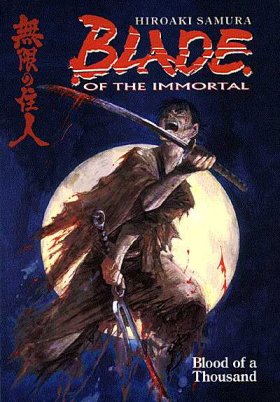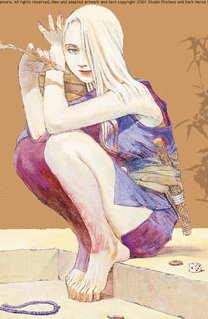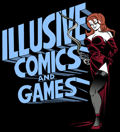| Blade
of the Immortal
Can quirky
humor and unwanted limb removal be two parts of the same comic
and still manage to make it work? Yes it can.
Horror
and humor have often blurred their respective boundaries and
run into each other: watching the Nightmare On Elm Street
series in its entirety over the last two weeks, I've become
painfully aware of just how funny blood spray and site gags
can be in conjunction.
But does
it work in comics? I sat down to type this and tried to remember
the last time I read a comic that balanced out horror with
hilarity, and nothing came readily to mind. Richard Moore's
Boneyard (probably the best comic out there that no
one is reading) from NBM Publishing uses the horror elements
of vampires and werewolves to tell charmingly funny stories,
but never uses actual gore to any measurable degree.
Which
inevitably leads me to my topic of review, Hiroaki Samura's
Blade Of The Immortal series, published in the U.S.
by Dark Horse.
Manji
is a ronin in feudal Japan, disenfranchised with the way of
the samurai. He sees the ancient system of warrior nobility
as a crock and rejects the world it encompasses by becoming
a hired killer. On his path, he came across an old woman who
gave him the kessen-chu, "the holy blood worms"
that never allow a man to die, but still to feel the pain
of his injuries.
After
a personal tragedy, and suffering the pain of countless "deaths,"
Manji has chosen to give up. He wants to die and makes a deal
with the old woman who gave him the damnable kessen-chu in
the first place: kill one thousand evil men and Manji will
finally be able to die. And from there, the story of Manji's
bloody journey begins.
The opening
sequence of the first collection, Blood of a Thousand,
is a damn good one and rivals the openings of some extremely
great action films. There's just something about a man getting
shot in the head through a confessional that clicks with me
visually. Samura is very good at setting scenes and displaying
the action of the characters, though at times he can get somewhat
muddled, favoring the illusion of speed on the page, rather
than exact placement of where a sword would poke out of a
ribcage.
Samura
also has done some very interesting things with his artwork
that I've rarely seen in manga: he switches styles between
panels. At times, the work is penciled and inked with crisp
attention to detail, and other times is just penciled pictorials,
almost like sketches but of higher detail. This is an effect
that he uses often for scenes where martial arts speed is
depicted, but he also uses the sketchy style in some of the
quieter scenes, using it to creepifying effect in one scene
where a young girl watches her father be butchered. I honestly
didn't know manga artists did this and I'm glad to see the
style-switch technique that has worked for countless American
artists (Sam Kieth's Zero Girl
springs to mind) being applied so deftly by Samura.
More surprising
than the quality artwork is the story that Samura puts together.
Manji is an unapologetic killer that the reader can honestly
believe is tired of life, without becoming too much of a pity
party character that mopes and seeks penance for the countless
deaths he's caused. While the story surrounding him isn't
as thick or in-depth as one might hope in a first volume,
I can see where Samura has left plot holes that can be filled
by later volumes, and I felt assured that more of the character's
back-story will be revealed.
But the
most surprising thing was the level of comedy mixed in with
the rampant killings and frightening visuals. Samura made
the decision to, while setting the story in feudal Japan,
to keep a more modern vernacular for the characters to speak
with. Manji and others swear and speak plainly. This creates
an easier atmosphere to insert sight gags and quips into,
and Samura does. The fight scene where Manji and the girl
he is protecting (in order to kill several evil people), is
a blood-soaked gore-fest of laughter for the whole family.
When Manji is asked by one of the many attackers if he thinks
he can kill all of them with just "one lousy sword,"
blades numbering in the double digits fall out of his kimono.
"Not
with one." I laughed for days.
You wouldn't
think that arms and heads and even some unidentifiable beefy
chunks flying around the page would be funny, but with Samura
placing sarcastic comments and comedic dialogue over the scenes,
he manages to make the gruesome just a touch more mad-cap.
Getting stabbed in the spine? Funny every time.
Blade
of the Immortal is sort of the anti-period piece, very
different from its distant cousin of samurai manga, Lone
Wolf & Cub. Not as serious as Koike's uber-series,
it's still a great example of good manga in the way it balances
humor and horror so very well. It doesn't lack for action.
It has interesting characters that, with a little bit more
characterization, could be great characters.
There
are some problems with the way the artwork from Japan was
transferred to American tastes (panels are flipped the wrong
way sometimes, showing facial scars on the wrong sides of
faces, swords in the wrong hands), but they're not distracting
to the story. It's well worth a pick-up at $14.95, so go out
and mix your funny with your fundamentally frightening tastes
and enjoy.
|







